Related Research Articles

The LGM-30 Minuteman is an American land-based intercontinental ballistic missile (ICBM) in service with the Air Force Global Strike Command. As of 2024, the LGM-30G is the only land-based ICBM in service in the United States and represents the land leg of the U.S. nuclear triad, along with the Trident II submarine-launched ballistic missile (SLBM) and nuclear weapons carried by long-range strategic bombers.

The LGM-118 Peacekeeper, originally known as the MX for "Missile, Experimental", was a MIRV-capable intercontinental ballistic missile (ICBM) produced and deployed by the United States from 1985 to 2005. The missile could carry up to twelve Mark 21 reentry vehicles, each armed with a 300-kiloton W87 warhead. Initial plans called for building and deploying 100 MX ICBMs, but budgetary concerns limited the final procurement; only 50 entered service. Disarmament treaties signed after the Peacekeeper's development led to its withdrawal from service in 2005.

START II was a bilateral treaty between the United States and Russia on the Reduction and Limitation of Strategic Offensive Arms. It was signed by US President George H. W. Bush and Russian President Boris Yeltsin on 3 January 1993, banning the use of multiple independently targetable re-entry vehicles (MIRVs) on intercontinental ballistic missiles (ICBMs). Hence, it is often cited as the De-MIRV-ing Agreement.
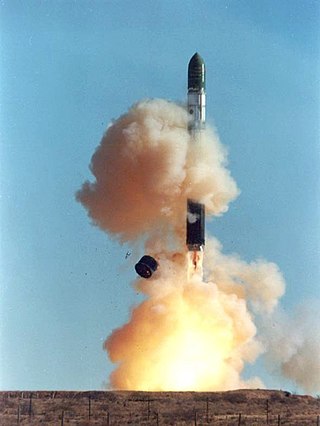
The R-36 is a family of intercontinental ballistic missiles (ICBMs) and space launch vehicles (Tsyklon) designed by the Soviet Union during the Cold War. The original R-36 was deployed under the GRAU index 8K67 and was given the NATO reporting name SS-9 Scarp. It was able to carry three warheads and was the first Soviet MRV missile. The later version, the R-36M, also known as RS20, was produced under the GRAU designations 15A14 and 15A18 and was given the NATO reporting name SS-18 Satan. This missile was viewed by certain United States analysts as giving the Soviet Union first strike advantage over the U.S., particularly because of its rapid silo-reload ability, very heavy throw weight and extremely large number of re-entry vehicles. Some versions of the R-36M were deployed with 10 warheads and up to 40 penetration aids and the missile's high throw-weight made it theoretically capable of carrying more warheads or penetration aids. Contemporary U.S. missiles, such as the Minuteman III, carried up to three warheads at most.

The Safeguard Program was a U.S. Army anti-ballistic missile (ABM) system designed to protect the U.S. Air Force's Minuteman ICBM silos from attack, thus preserving the US's nuclear deterrent fleet. It was intended primarily to protect against the very small Chinese ICBM fleet, limited Soviet attacks and various other limited-launch scenarios. A full-scale attack by the Soviets would easily overwhelm it. It was designed to allow gradual upgrades to provide similar lightweight coverage over the entire United States over time.

The maneuverable reentry vehicle is a type of warhead for ballistic missiles that is capable of maneuvering and changing its trajectory.
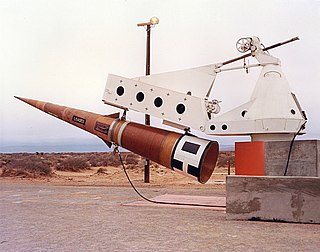
The Sprint was a two-stage, solid-fuel anti-ballistic missile (ABM), armed with a W66 enhanced-radiation thermonuclear warhead used by the United States Army during 1975–76. It was designed to intercept incoming reentry vehicles (RV) after they had descended below an altitude of about 60 kilometres (37 mi), where the thickening air stripped away any decoys or radar reflectors and exposed the RV to observation by radar. As the RV would be traveling at about 5 miles per second, Sprint needed to have phenomenal performance to achieve an interception in the few seconds before the RV reached its target.
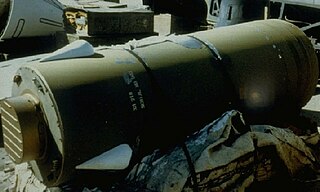
The W71 nuclear warhead was a US thermonuclear warhead developed at Lawrence Livermore National Laboratory in California and deployed on the LIM-49A Spartan missile, a component of the Safeguard Program, an anti-ballistic missile (ABM) defense system briefly deployed by the US in the 1970s.

The W62 was an American thermonuclear warhead designed in the 1960s and manufactured from March 1970 to June 1976. Used on some Minuteman III ICBMs, it was partially replaced by the W78 starting in December 1979, and fully replaced by W87 warheads removed from MX Peacekeeper missiles and retired in 2010.
Dense Pack is a strategy for basing intercontinental ballistic missiles (ICBMs) for the purpose of maximizing their survivability in case of a surprise nuclear first strike on their silos conducted by a hostile foreign power. The strategy was developed under the Reagan administration as a means of safeguarding America's inventory of MX missiles during the final decade of the Cold War. It was never used; MX was deployed in existing silos and then removed from service as the Cold War ended.
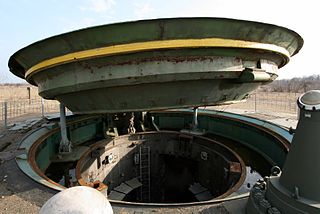
A missile launch facility, also known as an underground missile silo, launch facility (LF), or nuclear silo, is a vertical cylindrical structure constructed underground, for the storage and launching of intercontinental ballistic missiles (ICBMs), intermediate-range ballistic missiles (IRBMs), medium-range ballistic missiles (MRBMs). Similar facilities can be used for anti-ballistic missiles (ABMs).
In nuclear strategy, a counterforce target is one that has a military value, such as a launch silo for intercontinental ballistic missiles, an airbase at which nuclear-armed bombers are stationed, a homeport for ballistic missile submarines, or a command and control installation.
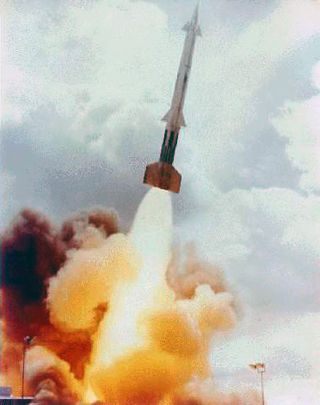
Nike Zeus was an anti-ballistic missile (ABM) system developed by the United States Army during the late 1950s and early 1960s that was designed to destroy incoming Soviet intercontinental ballistic missile warheads before they could hit their targets. It was designed by Bell Labs' Nike team, and was initially based on the earlier Nike Hercules anti-aircraft missile. The original, Zeus A, was designed to intercept warheads in the upper atmosphere, mounting a 25 kiloton W31 nuclear warhead. During development, the concept changed to protect a much larger area and intercept the warheads at higher altitudes. This required the missile to be greatly enlarged into the totally new design, Zeus B, given the tri-service identifier XLIM-49, mounting a 400 kiloton W50 warhead. In several successful tests, the B model proved itself able to intercept warheads, and even satellites.

Nike-X was an anti-ballistic missile (ABM) system designed in the 1960s by the United States Army to protect major cities in the United States from attacks by the Soviet Union's intercontinental ballistic missile (ICBM) fleet during the Cold War. The X in the name referred to its experimental basis and was supposed to be replaced by a more appropriate name when the system was put into production. This never came to pass; in 1967 the Nike-X program was canceled and replaced by a much lighter defense system known as Sentinel.

Sentinel was a proposed US Army anti-ballistic missile (ABM) system designed to provide a light layer of protection over the entire United States, able to defend against small ICBM strikes like those expected from China, or accidental launches from the USSR or other states. The system would have seventeen bases, each centered on its Missile Site Radar (MSR) and a computerized command center buried below it. The system was supported by a string of five long-range Perimeter Acquisition Radars (PAR) spread across the US/Canada border area and another in Alaska. The primary weapon was the long-range Spartan missile, with short range Sprint missiles providing additional protection near US ICBM fields and PAR sites. The system would initially have a total of 480 Spartan and 192 Sprint missiles.
Nuclear blackout, also known as fireball blackout or radar blackout, is an effect caused by explosions of nuclear weapons that disturbs radio communications and causes radar systems to be blacked out or heavily refracted so they can no longer be used for accurate tracking and guidance. Within the atmosphere, the effect is caused by the large volume of ionized air created by the energy of the explosion, while above the atmosphere it is due to the action of high-energy beta particles released from the decaying bomb debris. At high altitudes, the effect can spread over large areas, hundreds of kilometers. The effect slowly fades as the fireball dissipates.

Sentry, known for most of its lifetime as LoADS for Low Altitude Defense System, was a short-range anti-ballistic missile (ABM) design made by the US Army during the 1970s. It was proposed as a defensive weapon that would be used in concert with the MX missile, a US Air Force ICBM that was under development.
Swarmjet was an extremely short-range single-shot anti-ballistic missile (ABM) system proposed by the United States as a defensive measure during the development of the MX missile. It consisted of a launcher containing thousands of spin-stabilized unguided rockets that would be fired into the path of an enemy nuclear warhead, enough that it would be highly likely one of the rockets would hit the warhead and destroy it.
Dust defense, sometimes called environmental defense, was a proposed anti-ballistic missile (ABM) system considered for protecting both Minuteman and MX Peacekeeper missile silos from Soviet attack.
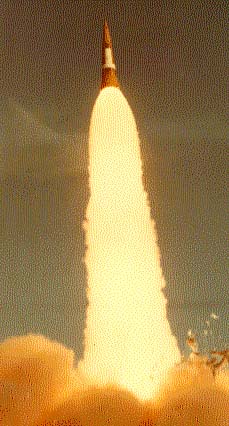
Hardpoint was a proposed short-range anti-ballistic missile (ABM) system conceived by ARPA and developed by the US Army under ARPA's Project Defender program. Hardpoint was designed to exploit the relatively low accuracy that Soviet ICBMs had, which would make destroying missile silos difficult. The idea was to only shoot at warheads which would be expected to impact within lethal distance of silos, ignoring the rest and allowing them to hit the ground. This acted as a force multiplier, allowing a small number of interceptors to offset a large number of Soviet missiles.
References
Citations
- 1 2 Garwin 1976, p. 53.
- ↑ Garwin 1976, p. 55.
- 1 2 3 4 5 6 7 8 9 10 Garwin 1976, p. 54.
- ↑ Garwin 1976, pp. 53–54.
- 1 2 Medalia 1981, p. 33.
- ↑ Garwin 1984, p. 392.
- ↑ Garwin 1976, p. 56.
- ↑ Boese, Wade (October 2005). "United States Retires MX Missile". Arms Control Today . 35 (8). Arms Control Association: 35–36. ISSN 0196-125X. JSTOR 23627780. LCCN 87656007. OCLC 1017367445. Archived from the original on 27 January 2022. Retrieved 5 July 2022.
- ↑ Garwin 1976, pp. 55–56.
- ↑ Garwin 1984, p. 396.
Bibliography
- Garwin, Richard (Autumn 1976). "Effective Military Technology for the 1980s". International Security. Vol. 1, no. 2. pp. 50–77. doi:10.2307/2538499. JSTOR 2538499.
- Garwin, Richard (1984). "Statements by Richard L. Garwin". In Carter, Ashton; Schwartz, David (eds.). Ballistic Missile Defense. Brookings Institution Press. ISBN 978-0-8157-0576-5.
- Medalia, Jonathan (28 September 1981). Assessing the Options for Preserving ICBM Survivability (Technical report). Congressional Research Service. pp. 50–77.
- Lieber, Keir; Press, Daryl (Autumn 1976). "The End of MAD?" (PDF). International Security. Vol. 30, no. 4. pp. 7–44.
- MacKenzie, Donald (1990). Inventing Accuracy: A Historical Sociology of Nuclear Missile Guidance. MIT Press. ISBN 978-0-262-13258-9.